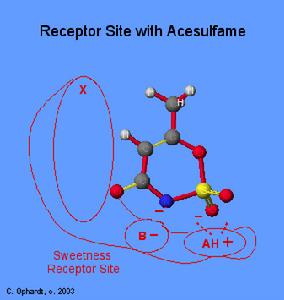Introduction:
Acesulfame-K - also known as Sunette, Sweet One, Sweet 'n Safe
Acesulfame-K was discovered in 1967 and is 150-200 times sweeter than sugar. Acesulfame-K is a highly stable, crystalline sweetener with a chemical structure is similar to saccharin.
Acesulfame-K is usually used in combination with aspartame or other sweeteners because it has a synergistic effect to enhance and sustain the sweet taste of foods and beverages. It is heat stable so it can be used in baked products. It does not provide calories since the body does not metabolize it and it is excreted in the urine without being changed.
Acesulfame-K is found in many foods, including chewing gum, desserts, alcoholic beverages, syrups, candies, sauces, and yogurt. It is found in Hershey's Lite Syrup and Fat Free Dutch Chocolate Hot Cocoa, Trident gum and sugar free jell-O.
It was approved for use by the FDA in 1988 and has been evaluated 8 times since for safety. It does not have to carry any warnings on the products it is in.
Sweetness Receptor Site:
although Acesulfame is most often used as the potassium salt for reasons of solubility, it would be protonated on the nitrogen in the saliva.
Note: The model receptor site is this author's conception and is based only very loosely on theory and geometry of the molecules. It is only useful for students' initial conceptions of the fit o

Area (AH+): This area has hydrogens available to hydrogen bond to oxygen that is part of the sulfur group.
Area (B -): This area has a partially negative oxygen available. The structure of Acesulfame with a negative Nitrogen does not fit the receptor site very well.
Area (X): This area is more or less perpendicular to the other two areas interacts through hydrophobic or non-polar properties to the non-polar methyl group and ring on the acesulfame molecule.
